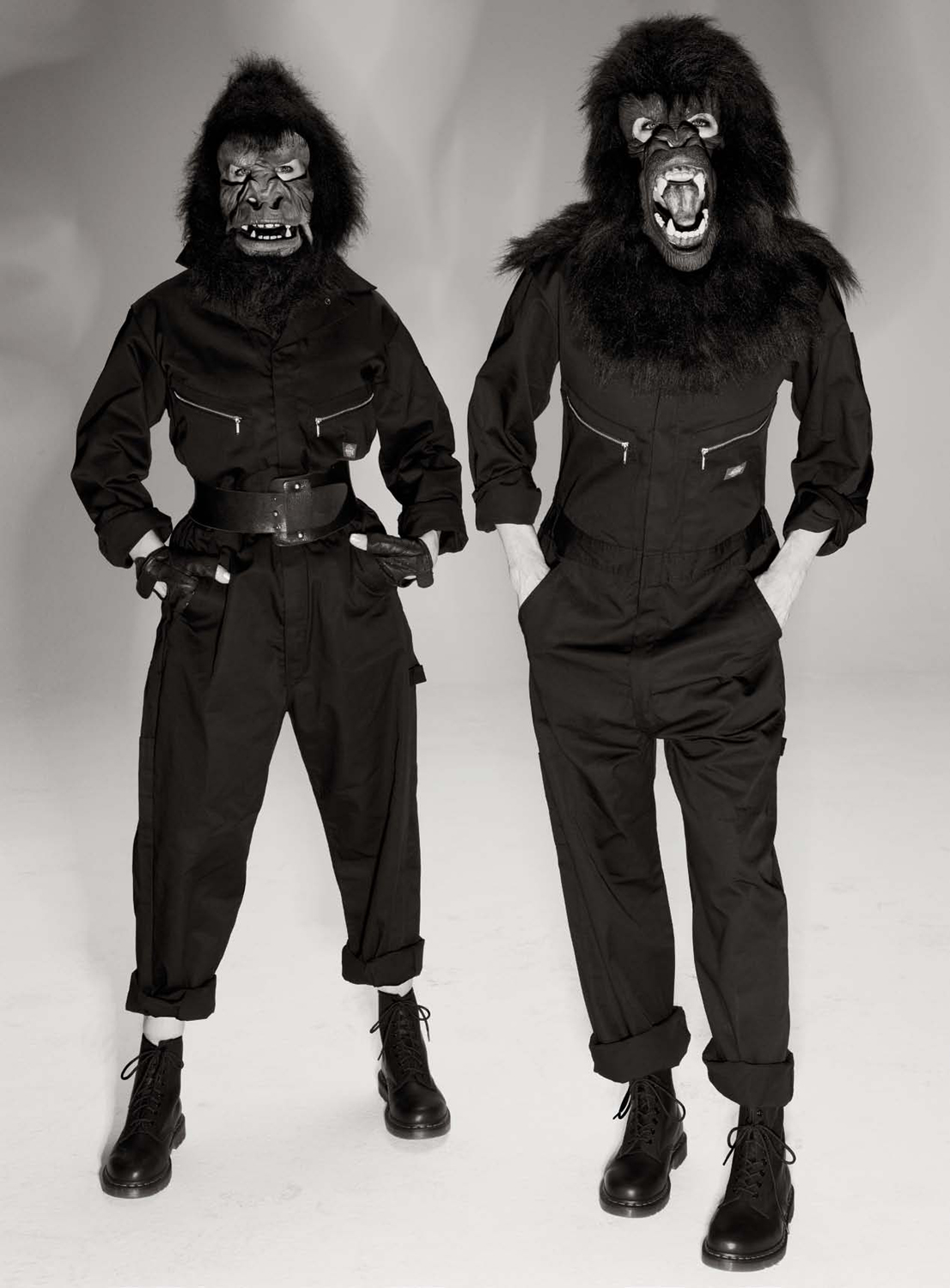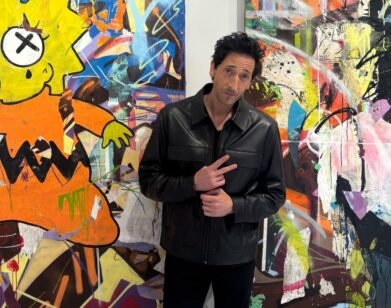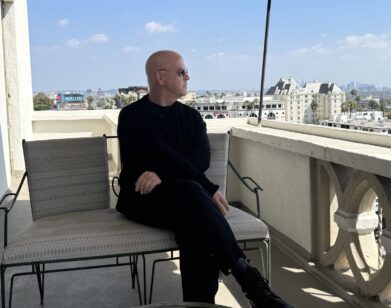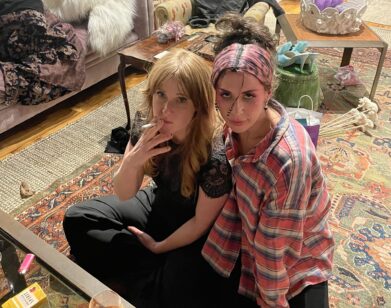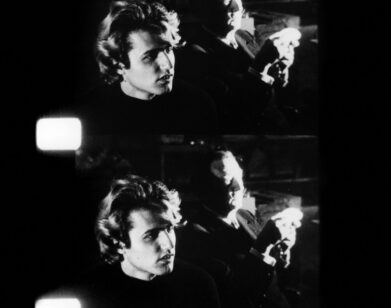Guerrilla Girls
In 1985, a group of New York-based women artists banded together to protest the rampant discrimination in a male curated, male-centric MoMA show (where out of the 169 artists represented, only 13 were female). Out of that spirit, the highly vocal, social-crime-fighting, vigilante, primate-masked, anonymous, but ever watchful (and score-keeping) feminist collective the Guerrilla Girls was born. Their ingenious, rabble rousing, and take-no-prisoners interventions have become the stuff of art world legend: papering city walls with posters decrying museum misconduct and creating alternative text books that expose the prejudicial, statistically lopsided facts absent in most art history 101 supplements are just two of their preferred modes of attack. One such poster, created in 1989, famously revealed a disheartening statistic about the Metropolitan Museum of Art (and featured an illustrated body of Ingres’s Grande Odalisque collaged with a fierce gorilla head): “Do women have to be naked to get into the Met. Museum? Less than 5% of the artists in the Modern Art sections are women, but 85% of the nudes are female.”
More than 20 years and a few generations of curators, critics, and collectors later, one might assume that the Guerrilla Girls have fulfilled their cultural purpose, and that the art world—presumably that great bastion of free, liberated thinking—has leveled the inequality in their ranks. In other words, hasn’t feminism accomplished its goals, and now aren’t women artists just as visibly represented, well-paid, and market-saturated as their male counterparts? Here is a quote from Activity #4 in The Guerrilla Girls’ Updated Art Museum Activity Book, due out this month from Printed Matter: “In 2011, we did our latest recount. We were sure things had improved, but surprise! Only 4% of the artists in the Modern and Contemporary sections were women, but 76% of the nudes were female. Fewer women artists, more naked males. Is this progress? Guess we can’t put our masks away yet.”
No way. In fact, where we stand culturally in 2012, the Guerrilla Girls are more relevant than ever. If the Occupy Wall Street movement—or at least that substrata of the movement interested in more overt political confrontations and shielding their identity in Guy Fawkes masks—looked for matron saints in the art world, it would be the ladies of GG, who have already proven that anonymous, message-aggressive, peaceful, in-your-face protest (with no dearth of clever signage) creates a winning formula for public exposure, institutional support, and, in some cases, real changes to the way the one percent at the top of the museum board thinks.
While in their 27 years, the Guerrilla Girls have had their ups and downs and their swells and constrictions as a group, their agenda against discrimination has only widened and intensified: Both their support of equal representation of queer artists and artists of color and their focus on the flow of money through art channels have become key platforms in their fact-finding missions. This month alone, GG has two new projects hitting the streets and penetrating our consciousnesses. Not only is their updated museum guide stocked with the recent salaries, disproportions in pay, and even suggestions for rewriting wall texts, but the Guerrilla Girls are also taking on the museums of Chicago with a little self-proclaimed “gender reassignment” project as part of the exhibition “Not Ready to Make Nice: Guerrilla Girls in the Art World and Beyond,” at Columbia College. To interview this radical guerrilla group, we asked 21 women artists working today to each pose a question, in a sense gauging and interrogating a movement that has come so far only to find that there is still such a long way to go.
CINDY SHERMAN: What’s the fewest and most Guerrilla Girls there have been at any one time, and do they try to recruit or maintain their existence? Or will it be like the shakers and they’ll eventually disappear, which would be sad?
GUERRILLA GIRLS: That’s one of our biggest secrets, but here’s a hint: you can’t be a huge group and do the kind of posters, billboards, books, and targeted actions we’ve done. Your fantasy about our size is probably more interesting than the reality. We’re lucky to do work that means something to people all over the world. The Guerrilla Girls may be gone someday, but there were, are, and always have been other crazy, creative activist groups. Go bananas, everyone.
RACHEL HARRISON: It’s amazing how instrumental your work has been in creating discussion about gender inequality in the art world, and that you’ve used humor to do so. I’ve always felt that the root of the problem is capitalism—the arts are just a reflection of the larger world in this way. When I was a kid, my mother gave me a button that said 59¢, which was what women earned for each dollar men made at that time—in the ’70s. It is now up to 77¢, which would indicate some change for the better, yet when it comes to young artists living in an expensive city like New York, it’s still so much easier for male artists to pay bills and survive than women. Women are up against basic life survival issues that matter more than the lack of inclusion in magazines like Interview. Nevertheless, according to my own online research, there are very few women artists in this magazine, which is possibly an indication of their core readership and how well hot young boys photograph these days. Do you think being in magazines helps women artists, and can you make a joke out of my question?
GUERRILLA GIRLS: First, let’s not stereotype hot young males. Second, we’re certain that Interview, as a result of this article, will mend their ways, avoid tokenism, and increase coverage of women artists and artists of color as interviewers and interviewees. Help us by bugging them if they don’t. We have lots of ideas for how to do that. Are you listening, Interview? The Guerrilla Girls have been complaining about greed and corruption in the art world and beyond for years. See our just-published, updated version of The Guerrilla Girls’ Art Museum Activity Book, a parody of those books museums give out to indoctrinate children. (Book launch at Printed Matter on March 31, 2012, 5 to 7 P.M.!) How can we trust art museums to preserve the history of our time when they’re run by super-rich art collectors who invest in art, then oversee what the museums show and collect? In any other market, that would be a conflict of interest or insider trading and could lead to time in the slammer. That’s why the Guerrilla Girls operate on a different economic paradigm of making small exchanges—books, posters, talks, workshops—with many individuals and institutions instead of getting big bucks from a few fat-cat collectors looking to manipulate the market. Sorry we got carried away and sorry this isn’t much of a joke!
ANICKA YI: With the recent signing of the NDAA, we are now all under martial law in this country. Anonymity is a key tool for dissent in this climate. How would the GG advise on more anonymous activism?
GUERRILLA GIRLS: Go for it. Anonymous free speech is protected by the constitution. You’d be surprised what comes out of your mouth when you wear a mask. Activists are occupying everywhere—so many, in fact, that the courts and jails can’t handle them.
XAVIERA SIMMONS: If the Guerrilla Girls will, please construct a clear, ideal vision of the future of the art world and of art world politics. What will that vision be and what simple manifesto can the GG help construct so that we all have a working shared language to draw from and activate with?
GUERRILLA GIRLS: Artists should stop making art only for the one percent and start making some art for the rest of us. That means changing everything: galleries, museums, collectors, critics, dealers—maybe even friends and lovers. That means making some cheap art that everyone can own—like books, music, and films. Check out the manifesto we gave to graduating students at the Art Institute of Chicago in 2010.
EMILY SUNBLAD: What were your demonstrations directed at museums and how did the museums respond?
GUERRILLA GIRLS: We love to go after museums because we worry that 100 years from now they will have collected the wrong stuff. We’ve done actions and street posters and infiltrated art institutions on almost every continent. Our first extended attack was a 1987 Clocktower show about the politics of the Whitney Biennial. We even had a deep throat in the development office smuggle out sensitive info about the trustees. The museum’s response: silence. Lately things have gotten surreal. Museums beg us to attack them. What do you do when the art world you’ve spent your whole life attacking suddenly embraces you? Well, you don’t waste time wondering if you’ve lost your edge. You take your critique right inside the joint. We dissed MoMA at its own symposium on feminism. We criticized the Tate Modern and the Istanbul Modern. Our latest poster skewers the museums of Chicago. The response? After we made fun of the National Gallery of Art, they vowed to change their ways. Ditto the Tate Modern and MoMA. Even the venerable Venice Biennale has improved a bit since our giant 2005 installation about its discriminating history. Whenever our work appears at an institution like that, we get tons of emails from people telling us that our work showed them something they never knew about art and culture.
KAARI EPSON: Who is your art world crush?
GUERRILLA GIRLS: We love Xabier Arakistain, Aka Arakis, the most committed, outrageous curator in all of Spain and probably the rest of the world. Arakis is and always has been a fearless feminist and is intent on founding the first center for feminist art in Europe. Arakis is a fashion icon, too!
ELIZABETH PEYTON: Do you think things have changed for women in the art world since you began? If so, how? Do you think in one’s own time, women seem more present, and then history cuts them out of the story.
GUERRILLA GIRLS: In the beginning, we worked in an atmosphere of disbelief: No one wanted to think the art world was anything less than a meritocracy. The kind of scrutiny applied to other fields was unwelcome. Now, it’s a no-brainer: You can’t write the history of a culture without all its voices. No curator or dealer wants to be considered a Neanderthal for not showing women or artists of color. We hope it stays that way. But the commercial art world completely sucks. With a few token exceptions, white guys still get most of the big money, and for sure the biggest opportunities.
DANA SCHUTZ: If the Guerrilla Girls had a theme song, what would it be and why?
GUERRILLA GIRLS: The Nominees Are: “Sisters, O Sisters” by Yoko Ono with Le Tigre, “Can’t Hold Us Down” by Christina Aguilera with Lil’ Kim, and “Not Ready to Make Nice” by the Dixie Chicks.
MICHELE ABELES: What do you see when you look in the mirror?
GUERRILLA GIRLS: Girls Going Ape!
CAROLE BOVE: What type of decision-making process do you use? Does everyone have to agree before you take an action?
GUERRILLA GIRLS: We don’t work on anything that a member finds completely objectionable, and we constantly agree to disagree. Sometimes there’s foot stomping and gnashing of teeth, but somehow things get done. It’s all kind of hormonal.
KERSTIN BRATSCH: Do you think women artists sometimes have a jaundiced eye for one another and that they tend to side with male artists more than with other women artists?
GUERRILLA GIRLS: You don’t do that, do you? Sometime back in the dark ages women artists realized that pretending to be one of the guys could only help one or two tokens at a time. Women can help themselves and each other a lot more when they form their own networks, like the guys have done for centuries.
JOSEPHINE MECKSEPER: I am curious about the spectacle quality of your actions and whether they might inadvertently perpetuate the notion of the artist as an inconsequential entertainer. Ulrike Meinhof and Gudrun Ensslin, the female leaders of the RAF group, were role models for us growing up in Germany in the ’70s. Does the persistent inequality in our society/art world ever provoke you to consider a less performative but more direct approach?
GUERRILLA GIRLS: Are you sure you’re talking about us? We do dress in jungle drag, but we’re not performers. We’re visual artists and culture jammers in the world of art, film, and politics. Our m.o. is to be as direct as possible. In fact, we get grief for being too in-your-face. We’ve done tons of posters, billboards, street banners, and stickers. We’ve criticized museums on their own walls—and on streets nearby. We put up anti-Hollywood billboards in L.A. at Oscar time. We attacked hate speech and sexual violence on the streets of Montreal. We’ve done hundreds of talks and workshops at universities and museums around the world. Our five books are standard textbooks in art, gender studies, cultural studies, and political science classes. We get thousands of letters from people telling us our work has inspired them to become activists, too. Please, Josephine, tell us how we can be more direct than this.
MIRANDA JULY: I’ve noticed the meaning of feminism evolves as I become older. You guys are sort of ageless in your masks, but what injustice feels more urgent to you than it did when you first started Guerrilla Girls in 1985?
GUERRILLA GIRLS: Corruption in the art world drives us crazy, but the lack of human rights for women and children all over the world, especially in areas of war and conflict, makes us APOPLECTIC. The slightly good news: it’s always been two steps forward, one step back, but feminism is changing women’s lives around the globe—very, very slowly in most places, and significantly in others. Even the most repressive countries have feminist movements—brave women often working in secret. By the way, we think it’s ridiculous that so many people in the U.S. who believe in the tenets of feminism, equal pay for equal work, freedom from sexual exploitation and abuse, the right to an education, control over their reproductive lives, etc., have been brainwashed by negative stereotypes in the media and society and refuse to call themselves feminists. And guys, that means you, too. Time to man up, whether you’re female, male, trans, etc. and speak up for women. Feminism don’t get no respect, but women’s rights, civil rights, and gay, lesbian and trans rights are the great human rights movements of our time.
TRACEY EMIN: I once interviewed the Guerrilla Girls for a TV program and you insinuated that I knew who you are . . . who are you? Seriously though . . . have you ever had sex with your guerrilla masks on?
GUERRILLA GIRLS: Loved doing that interview with you, Tracey. Is your final question a proposition? text us!
K8 HARDY: From your long collaboration, what have you learned is the best way to handle or avoid interpersonal conflict? Is there any specific structure or tactics that you have developed to continue working together? I realize this question is coming after a significant split in the group, however I am curious how your experience or retrospection can be helpful for new groups of collectives.
GUERRILLA GIRLS: Everything that happens in a 27-year relationship will happen in a 27-year collaboration—times 10. Many terrific women have been in and out of our group, some for a week, some for over a decade. We’ve always been a bunch of artists with strong personalities. Sure, we could have done some things differently. Our advice is to be realistic in spite of your idealism, stay honest with your collaborators and your public, and be prepared for anything.
HANNA LIDEN: Who’s your favorite trans artist? Who’s your favorite male artist? Who’s your favorite female?
GUERRILLA GIRLS: We don’t play favorites. We decided early on to never make choices between living artists because we support inclusion, not exclusion. We’re fine talking about dead people, so let’s say Claude Cahun, Rosa Bonheur, Billy Tipton, and Gladys Bentley are some of our favorite trans artists from history.
AMY SILLMAN: How and why have the GG tactics or actions changed over the time you’ve been working together as a group?
GUERRILLA GIRLS: We like to think our critique has deepened and our visuals have become more outrageous, but we still have the same philosophy about how to construct political art. We believe that some discrimination is conscious and some is unconscious and that we can embarrass the perpetrators into changing their ways. We don’t do posters and actions that simply point to something and say, “This is bad,” like a lot of political art. We try to twist an issue around and present it in a way that hasn’t been seen before, using facts and humor, in the hope of changing people’s minds. We use information in a surprising, transgressive manner to prove our case. We take on issues we are passionate about, but we don’t always succeed. If we don’t come up with something we think is worth putting out there, we don’t. We’ve never been systematic; we just go after one target after another. There are plenty to choose from.
MARINA ABRAMOVIC: Who creates limits?
GUERRILLA GIRLS: That sounds like a trick question! We could spend hours answering it, but for now we’ll answer with another question, why are the rights of women and LGBT people so limited around the world?
YOKO ONO: I know you look adorable, unique, and wise as gorillas, but I am sure all of you look uniquely wise and adorable as women of our race in such a way we have never experienced before. Would you, in some fashion, show yourselves as human women to expose us to the uniqueness of yourselves which no doubt supersedes your gorilla image? Maybe you could pose as women critics, tabloid reporters who would interview you in gorilla image. We just want to be proud of ourselves as women of our race. Would you do us a favor, just as you have done for gorillas for their image? My simple question is: Would you mind showing yourselves without the gorilla cover for the benefit of us poor human women who have very little to be proud of?
GUERRILLA GIRLS: We’d love to take those masks off, but would anyone listen to us without them? We discovered that the art world takes feminists more seriously when they use humor and wear a gorilla disguise. Pathetic! We think of it as our masculinity.
FOR MORE ON GUERRILLA GIRLS, VISIT THEIR WEBSITE.

